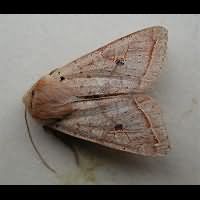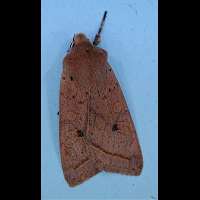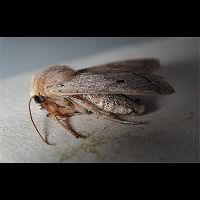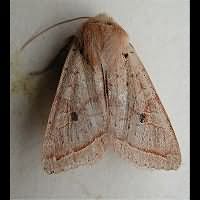Yellow-line Quaker Agrochola macilenta
The Yellow-line Quaker is usually identified by the outermost cross-line, which is narrow and which runs almost in one straight line. It is brownish or reddish with a yellow edge. The markings are almost identical to the Red-line quaker, but the two species can be told apart easily by looking at the ground colour. The Yellow-line Quaker may have any colour: reddish, brownish or yellowish, but it is never grey. The Red-line Quaker on the other hand is always greyish. Both species may do without the black dot, so apparent in the pictures. The Yellow-line Quaker is unmistakable because of the colour and the fact it is on the wing in autumn. It is a rather small Owlet Moth, for the wingspan is some 32 to 38mm only.
The eggs are laid in autumn and overwinter. They usually hatch in April and the caterpillar feeds until the beginning of June. It feeds during night time only. By day it hides between one or more leaves of the host plant which are spun together. The caterpillars fall to the ground in June, dig a hole and in this hole the make a cocoon. The spent quite some time dorment in this cocoon and it is not before August they pupate. The larva of the Yellow-line Quaker is hard to identify. It is brown with a light dorsal line and some light spots all over. The larva of the Red-line Quaker is almost identical, except it has more spots and it has a brown head. The Yellow-line Quaker's larva has a black head. It will reach a length of 35 to 40mm. Young caterpillars live in trees, such as oak, beech, sallow and many others. When they grow, they let themselves drop in the undergrowing vegetation where the development is completed. The diet is usually comprised of more than just one species of plant.
The Yellow-line Quaker is on the wing from early September to the end of November. It is attracted to both: sugar and light. In gardens it also visits blooming ivy and rotting fruit. Once caught some animals may be handled while taking pictures; others react immediately and remain restless all the time. Resident in Britain and Ireland and usually common. Even found in Northern Scotland and the Hebrides. Curiously enough quite rare on the Channel Islands.
The Yellow-line Quaker is usually identified by the outermost cross-line, which is narrow and which runs almost in one straight line. It is brownish or reddish with a yellow edge. The markings are almost identical to the Red-line quaker, but the two species can be told apart easily by looking at the ground colour. The Yellow-line Quaker may have any colour: reddish, brownish or yellowish, but it is never grey. The Red-line Quaker on the other hand is always greyish. Both species may do without the black dot, so apparent in the pictures. The Yellow-line Quaker is unmistakable because of the colour and the fact it is on the wing in autumn. It is a rather small Owlet Moth, for the wingspan is some 32 to 38mm only.
The eggs are laid in autumn and overwinter. They usually hatch in April and the caterpillar feeds until the beginning of June. It feeds during night time only. By day it hides between one or more leaves of the host plant which are spun together. The caterpillars fall to the ground in June, dig a hole and in this hole the make a cocoon. The spent quite some time dorment in this cocoon and it is not before August they pupate. The larva of the Yellow-line Quaker is hard to identify. It is brown with a light dorsal line and some light spots all over. The larva of the Red-line Quaker is almost identical, except it has more spots and it has a brown head. The Yellow-line Quaker's larva has a black head. It will reach a length of 35 to 40mm. Young caterpillars live in trees, such as oak, beech, sallow and many others. When they grow, they let themselves drop in the undergrowing vegetation where the development is completed. The diet is usually comprised of more than just one species of plant.
The Yellow-line Quaker is on the wing from early September to the end of November. It is attracted to both: sugar and light. In gardens it also visits blooming ivy and rotting fruit. Once caught some animals may be handled while taking pictures; others react immediately and remain restless all the time. Resident in Britain and Ireland and usually common. Even found in Northern Scotland and the Hebrides. Curiously enough quite rare on the Channel Islands.







